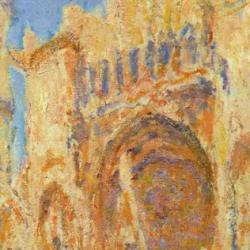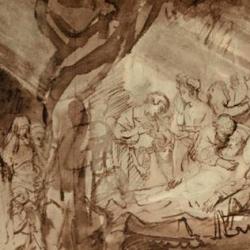Robin Parry’s The Biblical Cosmos is packed with good things. His opening discussion of the “living cosmos” of the Bible is wonderful – emphasizing the fact that God speaks to and commands animals, plants, stars, mountains, and the sea, and that these “inanimate” objects speak about God, and are even called to worship him (2-3). He concludes that though ancient Israelites didn’t believe that the “speech” of the cosmos was literal, they did see “something analogous to life, to consciousness, to intention, to speech, and to praise in the ‘inanimate’ aspects of creation. To us moderns the universe is mostly like a lifeless machine, but we need to be open to the possibility that the biblical authors saw the world as much more alive than we tend to” (4).
Parry includes deft overviews of Egyptian and Mesopotamian cosmologies; he explores the three-decker universe of the Bible, the biblical symbolism of the sea and Sheol, the biblical notion of stars, and the whole cosmos as the house of God. He acknowledges the parallels between ANE cosmology and the Bible (e.g., he argues that the host of heaven is the sun, moon and stars “conceived of as gods,” 108), but also highlights critical differences (e.g., the fact that the biblical writers “unanimously and emphatically rejected . . . any idea that humans should serve and worship . . . astral gods,” 109).
In the final section, Parry asks whether we moderns can live in the biblical world. At one level, he thinks the answer is an obvious No: “it is simply not possible for a modern Christian, even a fundamentalist, to believe the cosmos to have the exact physical structure that biblical authors believed it to have” – that is, “to believe that the earth is flat, that the sky is a solid dome beyond the stars with waters of chaos above it, that beneath the ground is the world of the dead, that heaven is literally up, and that the stars are divine beings” (165). Why could God communicate His truth through a scientifically erroneous worldview? Parry thinks that divine accommodation is part of the answer. His more basic answer is to stress that myth, though factually false, are metaphorically and metaphysically true.
To this, I have four fundamentalist questions, or lines of objection. First, I wonder if we really know what ancient Israelites believed about the “exact physical structure” of the universe. At times, Parry stresses the differences between biblical and modern cosmologies too much. He concludes from the Bible’s talk about the “four corners of the earth” and “the pillars of the earth” that ancient Israelites believed, like other ANE peoples, that the earth was a a flat disc (18-19). He’s appropriately cautious about whether or not Israelites believed that stars were members of the divine council (“there are reasons to think” so, 100). Of Psalm 148, he argues that angels are “very closely associated with the sun, moon, and stars,” but realizes that “it is not possible to dogmatically claim that they are identified” (107).
But the corner and pillar imagery is linked to the notion of the cosmos as God’s house. Parry doesn’t believe that Israelites thought the world literally a house, so it’s not clear why he takes this architectural imagery as an expression of literal beliefs about the shape of the world. Besides, if God accommodated Himself to erroneous ancient science, how is Parry able to distinguish between beliefs that Israelites took literally and those they did not? Parry is right to say that the heavenly hosts are associated with the visible heavenly bodies; that’s what we’d expect, I would think, if the visible heaven is an image of God’s dwelling. But he’s not shown that there is as much of a distance between the ancient and modern views as he seems to think.
Second, at some points at least we do still inhabit the universe of the Bible. For many practical purposes, the lived world is flat and that sky certainly does appear to be a hard dome over my head. I see the sun rise in the morning and set in the evening. I’m told that if I were standing outside the solar system, I’d see something different, but I’m not standing outside the solar system. So there seem to be many possible true descriptions of the world I inhabit, depending on the angle of observation: Who decided that standing outside the solar system is the only place from which to see reality as it is? Why does a scientific cosmology, whose proof I don’t understand, trump the evidence of my senses? (I could make the point more scientifically: We don’t believe in a geocentric universe anymore because we believe in a multi-centric universe; if any location can serve as center, why not earth?)
Third, Parry is naive about the character of science. He claims claims that “scientific explanations by their very nature do not regress infinitely but stop at the most basic laws of nature, for those laws are that in terms of which science seeks to explain the behavior of the universe” (200). But it’s highly questionable that science has discovered the “basic laws of nature,” or that it can, given its naturalist assumptions. Parry’s rhetoric suggests that he is comparing rock-solid science to the Bible, when in reality the science is porous and incomplete.
Finally, Parry makes some interesting moves in unpacking the latter claim. We can speak of the world as God’s cosmic house because of God’s active presence everywhere in it; heaven is to earth as soul is to body (181); even those divine stars have something to teach moderns, something about the interwoven duality of heaven and earth (193) and something about the un-mundane dimensions of mundane events (195). Parry’s observations in the final section harmonize ancient and modern to such a degree that it casts doubt on the opposition he argued for earlier in the book. In any case, that is both more consistent and less problematic than either the theory of accommodation or the notion that the Bible’s cosmology is metaphorically true.















